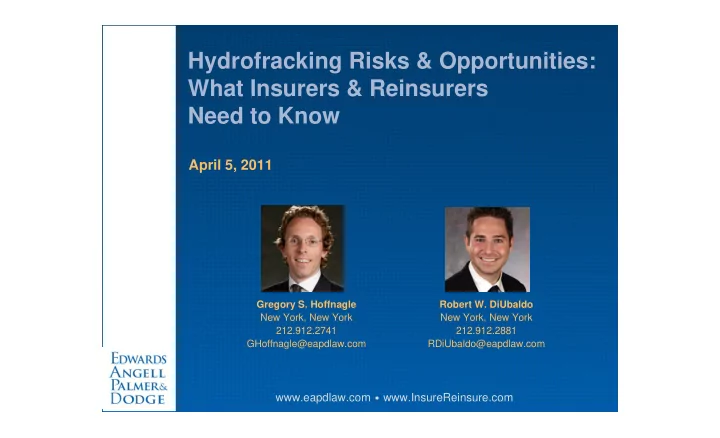

Hydrofracking Risks & Opportunities: What Insurers & Reinsurers Need to Know April 5, 2011 Gregory S. Hoffnagle Robert W. DiUbaldo New York, New York New York, New York 212.912.2741 212.912.2881 GHoffnagle@eapdlaw.com RDiUbaldo@eapdlaw.com www.eapdlaw.com • www.InsureReinsure.com
Hydraulic Fracturing (“Hydrofracking”): Outline of Webinar Hydrofracking 101 Brief Overview of the Evolving Regulatory Landscape Types of Exposures Fiorentino et al. v Cabot Oil & Gas Corp. et al. Potential Insurance/Reinsurance Implications Questions and Answers 2
What is Hydrofracking? Often oil- or gas-bearing formations have poor flow rates due to low permeability, or from damage or clogging of the formation during drilling of the access well Hydrofracking is a technique used to create fractures that extend from the well bore into shale formations to extract shale gas ( i.e., natural gas from shale) These fractures allow gas to travel more easily from the rock (shale) pores, where the gas is trapped, to the production well and then to the surface 3
What is Hydrofracking? (con’t) Typically, in order to create these fractures large amounts of pressurized water, “proppants” (sand or ceramic beads) and chemicals (diesel), are injected into underground shale formations In oil and gas exploration, before hydrofracking, shale used to be considered the “sorry rock” drilled through to get to good reservoir rock – sandstone, limestone or dolomite to get to the oil 4
How Hydrofracking Works 5
Why is Shale Gas on the Rise? Over approximately the past 20 years, shale has come to the forefront as a major productive form of producing useable “cleaner” energy The more recent push can be primarily linked to several factors 1. Hydrofracking 2. High-volume Horizontal Drilling/Hydrofracking 3. Higher prices for crude oil and natural gas (import) made it financially viable to drill 4. National Security 5. Unemployment – “Jobs” 6. President Obama’s “Blueprint for a Secure Energy Future” 6
Horizontal vs. Vertical Hydrofracking 7
Hydrofracking Numbers: Size and Scope Generally done between 5,000-20,000 feet below earth surface 8,000 feet = 6.5 Empire State Buildings 20,000 feet = 16 Empire State Buildings 8
Hydrofracking Numbers: Size and Scope Generally, 1-8 million gallons of water may be used to Hydrofrack a well 60-90% of fluids sent down into the well remain underground A well may be Hydrofracked up to 18 times More than 200 chemicals may be used in Hydrofracking fluid For each Hydrofrack, 80-300 tons of chemicals may be used 9
Hydrofracking Numbers: Size and Scope Hydrofracking equipment operates over a range of pressures and injection rates Can reach up to 15,000 pounds per square inch (psi) and can produce 100 barrels gas per minute Evaporators evaporate off volatile organic compounds (VOCs) and condensate tanks steam off VOCs, 24 hours a day, seven days a week There are currently approximately 495,000 shale gas wells in the U.S. Texas has approximately 93,000 wells Pennsylvania has approximately 71,000 wells The EPA projects that by 2020, shale gas will comprise over 20-35% of the nation's gas supply 10
U.S. Shale Gas Basins As of 2010 “Saudi Arabia of Natural Gas” 11
Northeastern U.S. Shale Gas 12
Brief Overview of the Evolving Regulatory Landscape: Federal Laws Safe Drinking Water Act (SDWA) The Energy Policy Act of 2005 “Halliburton Loophole” Fracturing Responsibility and Awareness of Chemicals Act of 2009 (FRAC Act) 13
Brief Overview of the Evolving Regulatory Landscape: Federal Laws to Keep in Mind Clean Water Act (CWA) Clean Air Act (CAA) Comprehensive Environmental Response Compensation and Liability Act (CERCLA) 14
Hydrofracking: Types of Risks Some environmental and human health concerns possibly associated with Hydrofracking include: Contamination of aquifer/ground water Contamination of fresh/navigable surface waters Contamination of air quality 15
Hydrofracking: Types of Risks Property Damage (devaluation) Migration of gases and hydrofracking chemicals to the surface Impacts on rock shelf causing seismic events or lead to surface subsidence Presure explosions Loss of land value/enjoyment Contamination/loss of crops and livestock Accidents in the transportation, handling and storage of toxic waste/chemicals 16
Hydrofracking: Types of Claims Violation of Federal Statutes (CWA, CAA, CERCLA) Violation of State Environmental Statutes Negligence Per Se/ Res Ipsa Loquitur Breach of Contract Medical Monitoring Trust Fund Statutory Claims Common Law Causes of Action Negligence/Gross Negligence/Strict Liability Negligence Per Se/ Res Ipsa Loquitur Private/Public Nuisance Trespass Misrepresentation/Fraudulent Misrepresentation 17
Fiorentino et al. v. Cabot Oil & Gas Corp. et al. Plaintiff’s claim that (improper) Hydrofracking caused the release of methane, natural gas and other toxins onto plaintiff’s land and into their groundwater As a result, plaintiff’s suffer and will suffer current and future illnesses and emotional distress Plaintiff’s seek: Injunction prohibiting future Hydrofracking operations Compensatory and punitive damages Cost of future health monitoring Attorney’s fees and costs 18
Fiorentino et al. v. Cabot Oil & Gas Corp. et al. (con’t) On November 15, 2010, the District Court denied most of defendants’ motion to strike and motion to dismiss The Court held the following: Property owners sufficiently plead claims against defendants which allege that defendants were/are responsible for Causing release of hazardous substances Failing to take necessary steps to remedy contaminated water supplies Plaintiffs becoming physically sick and ill in a manner that could continue into the future Costs incurred by plaintiffs to respond to defendants release of hazardous substances and contaminants, including but not limited to Costs of health assessments/effects study Medical monitoring 19
Potential Insurance Implications of Hydrofracking Commercial General Liability Policy Claims Environmental Policy Claims Directors and Officers (D&O) Policy Claims Engineers and Architects (E&O) Policy Claims Worker’s Comp Policy Claims Operators’ Extra Expense (Control of Well) Policy Claims 20
Potential Insurance/Reinsurance Considerations Notice Aggregation – event, occurrence, cause, series, arising out of, common origin Allocation Exclusions Follow the settlements/Follow the fortunes Inuring Clauses Clash covers 21
Recommend
More recommend